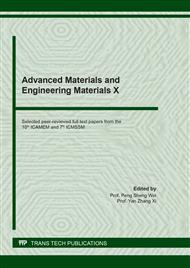[1]
H. Goli, M. Latifi, Evaluation of the effect of moisture on behavior of warm mix asphalt (WMA) mixtures containing recycled asphalt pavement (RAP), Constr. Build. Mater. 247 (2020) 118526.
DOI: 10.1016/j.conbuildmat.2020.118526
Google Scholar
[2]
R. West, Carolina Rodezno, Grant Julian, Brian Prowell, Engineering properties and field performance of warm mix asphalt technologies, Natl. Coop. Highw. Res. Program, Washington, DC, USA, NCHRP Final Rep. Proj. (2014) 360.
Google Scholar
[3]
G. Cheraghian, A. Cannone Falchetto, Z. You, S. Chen, Y.S. Kim, J. Westerhoff, K.H. Moon, M.P. Wistuba, Warm mix asphalt technology: An up to date review, J. Clean. Prod. 268 (2020) 122128.
DOI: 10.1016/j.jclepro.2020.122128
Google Scholar
[4]
P. Caputo, A.A. Abe, V. Loise, M. Porto, P. Calandra, R. Angelico, C.O. Rossi, The role of additives in warm mix asphalt technology: An insight into their mechanisms of improving an emerging technology, Nanomaterials. 10 (2020) 1–17.
DOI: 10.3390/nano10061202
Google Scholar
[5]
B.V. Kök, M. Akpolat, Effects of Using Sasobit and SBS on the Engineering Properties of Bitumen and Stone Mastic Asphalt, J. Mater. Civ. Eng. 27 (2015) 04015006.
DOI: 10.1061/(asce)mt.1943-5533.0001255
Google Scholar
[6]
Y. Kim, J. Lim, M. Lee, S. Kwon, S. Hwang, J. Lee, Comprehensive evaluation of warm SMA using wax-based WMA additive in Korea, J. Test. Eval. 43 (2015) 1230–1238.
DOI: 10.1520/jte20130144
Google Scholar
[7]
H. Zelelew, C. Paugh, M. Corrigan, S. Belagutti, J. Ramakrishnareddy, Laboratory evaluation of the mechanical properties of plant-produced warm-mix asphalt mixtures, Road Mater. Pavement Des. 14 (2013) 49–70.
DOI: 10.1080/14680629.2012.735799
Google Scholar
[8]
M.O. Hamzah, L. Gungat, N.I. Yusoff, J. Valentin, Recycled Asphalt Pavement with Warm Mix Additive for Sustainable Road Construction, Int. J. Civil, Environ. Struct. Constr. Archit. Eng. 10 (2016) 313–316.
Google Scholar
[9]
J. Oner, B. Sengoz, Research article utilization of recycled asphalt concrete with warm Mix Asphalt and cost-benefit analysis, PLoS One. 10 (2015) e116180.
DOI: 10.1371/journal.pone.0116180
Google Scholar
[10]
R.B. Mallick, P.S. Kandhal, R.L. Bradbury, Using warm-mix asphalt technology to incorporate high percentage of reclaimed asphalt pavement material in asphalt mixtures, Transp. Res. Rec. 2051 (2008) 71–79.
DOI: 10.3141/2051-09
Google Scholar
[11]
X. Shu, B. Huang, E.D. Shrum, X. Jia, Laboratory evaluation of moisture susceptibility of foamed warm mix asphalt containing high percentages of RAP, Constr. Build. Mater. 35 (2012) 125–130.
DOI: 10.1016/j.conbuildmat.2012.02.095
Google Scholar
[12]
X. Zhu, Y. Sun, C. Du, W. Wang, J. Liu, J. Chen, Rutting and fatigue performance evaluation of warm mix asphalt mastic containing high percentage of artificial RAP binder, Constr. Build. Mater. 240 (2020) 117860.
DOI: 10.1016/j.conbuildmat.2019.117860
Google Scholar
[13]
F. Moghadas Nejad, A. Azarhoosh, G.H. Hamedi, H. Roshani, Rutting performance prediction of warm mix asphalt containing reclaimed asphalt pavements, Road Mater. Pavement Des. 15 (2014) 207–219.
DOI: 10.1080/14680629.2013.868820
Google Scholar
[14]
Z. Zhou, X. Gu, Q. Dong, F. Ni, Y. Jiang, Rutting and fatigue cracking performance of SBS-RAP blended binders with a rejuvenator, Constr. Build. Mater. 203 (2019) 294–303.
DOI: 10.1016/j.conbuildmat.2019.01.119
Google Scholar
[15]
S.I. Vahora, C.B. Mishra, Investigating the Performance of Warm Mix Additives, Int. J. Curr. Eng. Technol. 7 (2017) 1011–1015.
Google Scholar
[16]
A. Yousefi, A. Behnood, A. Nowruzi, H. Haghshenas, Performance evaluation of asphalt mixtures containing warm mix asphalt (WMA) additives and reclaimed asphalt pavement (RAP), Constr. Build. Mater. 268 (2021) 121200.
DOI: 10.1016/j.conbuildmat.2020.121200
Google Scholar


